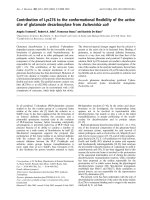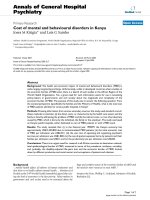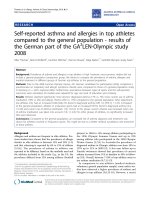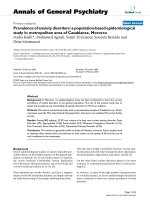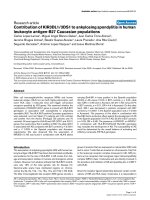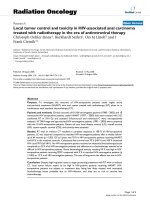Báo cáo y học: "Contribution of psychoacoustics and neuroaudiology in revealing correlation of mental disorders with central auditory processing disorders" ppt
Bạn đang xem bản rút gọn của tài liệu. Xem và tải ngay bản đầy đủ của tài liệu tại đây (231.78 KB, 5 trang )
BioMed Central
Page 1 of 5
(page number not for citation purposes)
Annals of General Hospital
Psychiatry
Open Access
Review
Contribution of psychoacoustics and neuroaudiology in revealing
correlation of mental disorders with central auditory processing
disorders
V Iliadou* and S Iakovides
Address: 3rd Department of Psychiatry, Aristotle University of Thessaloniki, AHEPA University Hospital, Greece
Email: V Iliadou* - ; S Iakovides -
* Corresponding author
psychoacousticsmental disorderscentral auditory processing disorders
Abstract
Background: Psychoacoustics is a fascinating developing field concerned with the evaluation of
the hearing sensation as an outcome of a sound or speech stimulus. Neuroaudiology with
electrophysiologic testing, records the electrical activity of the auditory pathways, extending from
the 8
th
cranial nerve up to the cortical auditory centers as a result of external auditory stimuli.
Central Auditory Processing Disorders may co-exist with mental disorders and complicate
diagnosis and outcome.
Design: A MEDLINE search was conducted to search for papers concerning the association
between Central Auditory Processing Disorders and mental disorders. The research focused on
the diagnostic methods providing the inter-connection of various mental disorders and central
auditory deficits.
Measurements and Main Results: The medline research revealed 564 papers when using the
keywords 'auditory deficits' and 'mental disorders'. 79 papers were referring specifically to Central
Auditory Processing Disorders in connection with mental disorders. 175 papers were related to
Schizophrenia, 126 to learning disabilities, 29 to Parkinson's disease, 88 to dyslexia and 39 to
Alzheimer's disease. Assessment of the Central Auditory System is carried out through a great
variety of tests that fall into two main categories: psychoacoustic and electrophysiologic testing.
Different specialties are involved in the diagnosis and management of Central Auditory Processing
Disorders as well as the mental disorders that may co-exist with them. As a result it is essential
that they are all aware of the possibilities in diagnostic procedures.
Conclusions: Considerable evidence exists that mental disorders may correlate with CAPD and
this correlation could be revealed through psychoacoustics and neuroaudiology. Mental disorders
that relate to Central Auditory Processing Disorders are: Schizophrenia, attention deficit
disorders, Alzheimer's disease, learning disabilities, dyslexia, depression, auditory hallucinations,
Parkinson's disease, alcoholism, anorexia and childhood mental retardation. Clinical awareness
should be high in order for doctors of the two specialties, psychiatry and otorhinolaryngology-
audiology to collaborate.
Published: 20 May 2003
Annals of General Hospital Psychiatry 2003, 2:5
Received: 23 April 2003
Accepted: 20 May 2003
This article is available from: />© 2003 Iliadou and Iakovides; licensee BioMed Central Ltd. This is an Open Access article: verbatim copying and redistribution of this article are permitted
in all media for any purpose, provided this notice is preserved along with the article's original URL.
Annals of General Hospital Psychiatry 2003, 2 />Page 2 of 5
(page number not for citation purposes)
Background
Evaluation of the central auditory nervous system (CANS)
is essential in order to obtain information on its anatom-
ical and functional integrity. Both, children and adults
may suffer from central auditory processing disorders
(CAPD). This fact has been underestimated but as re-
search in this field progresses, it shows that specific men-
tal disorders may be the outcome of a CAPD or that CAPD
can co-exist with a neurological or mental disorder [1].
Assessment of the CANS begun at the mid-1950s with the
confirmation by Bocca and his colleagues [2] that CANS
disorders do exist and that there are sensitive tests to re-
veal them. However, at that time acceptance of the new di-
agnostic methods by the audiologists, who were the first
to be interested in this field was limited. This can be attrib-
uted to the slow acceptance of each new method before it
is fully validated. Better understanding of the anatomy
and physiology of the CANS was gained by advances con-
cerning the presence and physiology of neurotransmitters
and the accumulation of data on the psychoacoustic and
electrophysiologic tests [3]. As a result audiologists started
applying the new diagnostic tests more often and appreci-
ated their contribution. Other medical specialties became
aware and interested in the disorders of the CANS. These
were mainly psychiatry and neurology. The assessment of
the CANS is also of great value concerning neuropsychol-
ogy and special education [4–6].
Anatomy and physiology of the CANS
Clinical evaluation of central auditory function requires
understanding of the anatomy and physiology of the
CANS and appreciation of its complexity. The CANS ex-
tends from the anterior and posterior cochlear nuclei
which are situated on the surface of the inferior cerebellar
peduncle to the auditory cortex. In between important
structures through which nerve fibers pass are: the trape-
zoid body, the lateral lemniscus, the inferior colliculus,
the medial geniculate body and the acoustic radiation of
the internal capsule. The auditory cortex includes the
gyrus of Heschl on the upper surface of the superior tem-
poral gyrus, the planum temporale and the Silvian fissure.
It is essential to point out that nerve impulses from each
ear proceed along auditory pathways on both sides of the
brainstem. Both ipsilateral and contralateral pathways are
important in ensuring interchange of auditory informa-
tion. The contralateral pathway exhibits dominance as op-
posed to the ipsilateral one [7]. Thirty thousand afferent
auditory nerve fibers with different range of frequency re-
sponse are responsible for conveying auditory informa-
tion to the cortex [8]. Many components of the stimulus
are analyzed separately. There is an increasing complexity
of the whole process in the auditory cortex. One should
keep in mind that, understanding of the exact way of
processing the auditory information at the level of the au-
ditory cortex, is still incomplete. It is in this understanding
that Phychoacoustics helps as it is the science concerned
with the evaluation of the sensation of hearing as an out-
come of the sound or speech stimulus.
Components of central auditory processing
Central auditory processing occurs prior to language com-
prehension [9]. It consists firstly of auditory discrimina-
tion, which is responsible for the ability to group sounds
according to how similarly or differently they are heard.
Auditory memory is the component responsible for stor-
ing and recalling auditory information. Auditory percep-
tion concerns the reception and understanding of sounds
and words. It plays a significant part in reading skills,
managing verbal information, communication and social
relationships. Auditory-vocal association consists of the
interaction between what is heard and verbal response.
Auditory synthesis is responsible for combining sounds or
syllables to formulate comprehensible patterns (words)
and de-combining words into separate sounds. Auditory-
vocal automaticity is the ability to predict how future lin-
guistic events will be heard by utilizing past experience.
Auditory figure-ground plays a role in diminishing
sounds which are not important while focusing on others
[10]. It is due to this component that someone can listen
to another person talking in a railway station, where a lot
of environmental noise exists.
Material and methods
The medline research revealed 564 papers when using the
keywords 'auditory deficits' and 'mental disorders'. 79 pa-
pers were referring specifically to CAPD in connection
with mental disorders, as this is a new term for auditory
deficits and one mostly used by audiologists. Auditory
deficit is a more general term used mostly by psychiatrists.
Both terms refer to the same disorder. It is essential to
point out that 25 of the 79 papers are published between
2000 – 2003.
Schizophrenia is found related to CAPD in 175 papers, 49
of them are published between 2000 – 2003 showing the
research focus of the last three years. Learning disabilities
were found related to CAPD in 126 papers. Parkinson's
disease was related to CAPD in 29 papers. Dyslexia is re-
lated to CAPD in 88 papers, 37 of them are between
2000–2003. Alzheimer's disease and auditory deficits are
connected in 39 papers. The remaining articles are on de-
pression, alcoholism, anorexia and childhood mental re-
tardation, all being related to some extend to CAPD.
Assessment of the CANS is carried through a great variety
of tests that fall into two main categories: psychoacoustic
and electrophysiologic testing. Psychoacoustic tests are
Annals of General Hospital Psychiatry 2003, 2 />Page 3 of 5
(page number not for citation purposes)
considered more subjective. Electrophysiologic ones are
more objective with the exception of P300 component.
Results
psychoacoustic tests
Learning disabilities, attention deficit disorders and dys-
lexia are assessed through a great variety of psychoacoustic
tests. Age limitations have to be considered [11] and spe-
cially designed tests are used for different age groups.
When evaluating children who are less than 12 years old
an important step is the Pediatric Speech Intelligibility
(PSI) Test. This consists of single words and sentences pre-
sented with a competing message at varying levels of dif-
ficulty [12]. In this test it is essential that performance is
adjusted for language age according to previously deter-
mined normative data [13]. Evaluation of this test may
provide the cause of learning disabilities including dyslex-
ia [14,15].
Children older than 12 years old are assessed through a
more complex test battery that contains several tests.
These tests are based on the stimulation of the auditory
system with tones, numbers, syllables, words and sentenc-
es. Evaluation is made according to the different compo-
nents of the auditory processing. One widely used test is
that of the dichotic digits which consists of different pairs
of numbers presented simultaneously to each ear [16].
The person under examination has to repeat all four num-
bers regardless of order. This test is easy to use in order to
detect the auditory deficit of dyslexia particularly since it
does not contain language and phonological parameters
[17].
The Staggered Spondaic Word Test (SSW) consists of two-
syllable spondaic words that are presented simultaneous-
ly to each ear [18]. This involves the diagnosis of auditory
deficits in attention disorders, autism, learning disabilities
and chronic alcoholism [19,20].
A series of experiments were planned by Nielzen and Ols-
son on the basis of psychoacoustic handling of auditory
stimulation. The results of these psychacoustic experi-
ments show significant differences between a group of
schizophrenic patients and a group of reference subjects
thus indicating central auditory processing disorders even
in a phase of illness remission or during treatment with
neuroleptics [21].
electrophysiologic tests
In all mental disorders assessed with the suspicion of
CAPD an objective measure of the peripheral auditory sys-
tem is mandatory. The Auditory Brainstem Responses
(ABR), measure the electrophysiologic activity from the
8
th
cranial nerve to the medial geniculate body of the
brainstem [22]. A very important element of ABR evalua-
tion is the morphology and synchronization of the wave-
form. One should always begin his evaluation while
observing waveform changes on real time [23].
The Auditory Middle Latency Responses (AMLRs) provide
an electrophysiologic measure of the primary auditory
cortex function [24]. The AMLRs can diagnose central au-
ditory processing disorders in children with learning disa-
bilities [25], patients with Alzheimer's disease [26], adult
autistic subjects [27,28] patients with Schizophrenia [29]
The Auditory P
300
Response, which consists of the meas-
ure of the hippocampal and auditory cortex function
again from an electrophysiological point of view [30]. The
P300 response has been considered an endogenous event-
related potential. Endogenous responses depend both on
the context within which the auditory stimuli are present-
ed and the psychologic condition and attention of the
subject. P300 has been used in diagnosing CAPD in pa-
tients with dementia of the Alzheimer type [31], in moni-
toring long-term effects of donepezil in patients with
Alzheimer's disease [32], in anorexic patients [33], in chil-
dren with mental retardation during a selective attention
task to auditory stimuli [34] and in first episode and
chronic schizophrenia [35]. Mismatch Negativity Re-
sponse (MMN) is an event-related evoked potential that
measures the electrophysiologic activity of the auditory
cortex function [36]. The MMN is always elicited 100–250
msecs from stimulus change onset. Its application is in de-
tecting CAPD in alcoholism [37], in Schizophrenia [38–
43], in attention deficit and in developmental dyslexia
[44].
psychoacoustic and electrophysiologic testing according to
type of lesion
In the selection of tests for the evaluation of brainstem le-
sions the examiner should keep in mind that all psychoa-
coustic tests have been reported to aid in the diagnosis.
According to the studies of Kartz [45] the Staggered
Spondaic Words Test may help differentiating brainstem
from cortical lesions and upper from lower brainstem le-
sions. Musiek et al [46] concluded that Auditory Brain-
stem Responses in combination with either Masking Level
Differences or Dichotic Digits Test may be as sensitive in
evaluating a group of patients suffering from multiple
sclerosis as a seven test battery. Jerger et al [47] reported
that for patients suffering from multiple sclerosis the best
test battery was a combination of stapedial reflex meas-
ures and speech audiometry.
The usual finding in central auditory tests regarding corti-
cal lesions is a deficit or impairment in the ear contralat-
eral to the side of lesion. Psychoacoustic tests such as
Dichotic Digits and SSW in patients with well document-
ed cortical and hemispheric lesions demonstrate primari-
ly contralateral ear deficits and impairments [48]. Two
Annals of General Hospital Psychiatry 2003, 2 />Page 4 of 5
(page number not for citation purposes)
exceptions that the examiner should always keep in mind
are when frequency and duration tests are applied and
when compromise of auditory fibers of the corpus callo-
sum has occurred [49].
Regarding interhemispheric dysfunction, test results may
be difficult to evaluate. Representation of auditory infor-
mation at the cortical level is mostly contralateral as is
clearly depicted in dichotic listening situations. When
speech responses are required by the subject auditory in-
formation from the right ear are projected through to the
left hemisphere without the participation of the opposite
hemisphere for the production of a speech response. On
the contrary auditory stimuli from the left ear must cross
the midline through the corpus callosum for the produc-
tion of a speech response. Patients with split brain disor-
ders subjected to dichotic testing have interestingly
demonstrated decreased scores regarding the left ear and
enhanced scores in the right ear [50,51].
Considerable evidence has been reported that indicates a
relation between various learning disabilities, including
dyslexia, attention deficit hyperactivity disorder and poor
performance scores on central auditory tests Learning dis-
abilities in children might be the expression of various un-
derlying central auditory disorders such as maturational,
developmental or neurological as depicted by abnormal
CAPD test results [52].
Conclusions
CANS assessment represents a fascinating field. Coopera-
tion of professionals in psychiatry, neurology, neuropsy-
chology and pediatric psychology, with the
otolaryngologist-audiologist is a prerequisite. Central au-
ditory processing disorders may co-exist with various
mental disorders such as: learning disabilities, attention
deficit hyperactivity disorder, dyslexia, autism, chronic al-
coholism, Alzheimer's disease, adult autistic disorder,
Schizophrenia, anorexia and mental retardation. Assess-
ing these disorders is difficult due to the complex anato-
my and physiology of the CANS. This explains the great
variety of existing methods of testing with two main cate-
gories: those of psychoacoustic methodology and those
based on electrophysiologic measures. Physiology of
CANS is still not completely understood and further re-
search is needed on development of new tests and valida-
tion of their clinical applicability.
Conflict of interest
none declared
References
1. Musiek FE and Lamb L From Central Auditory Assessment, an
overview In Handbook of Clinical Audiology (Edited by: Katz J)
Philadelphia Lippincott Williams & Wilkins 1994, 197-211
2. Bocca E, Calearo C and Cassinari V A new method for testing
hearing in temporal lobe tumors Acta Otolaryngol 1954, 44:219-
221
3. Musiek F and Hoffman D An introduction to the functional neu-
rochemistry of the auditory system Ear Hear 1990, 11:395-402
4. Scherg M and Von Cramon D Psychoacoustic and electrophysi-
ologic correlates of central hearing disorders in man Eur Arch
Psychiatry Neurol Sci 1986, 236:56-60
5. Demarco S, Harbour A, Hume G and Givins G Perception of time-
altered monosyllables in a specific group of phonologically
disordered children Neuropsychologia 1989, 27:753-757
6. Bamiou DE, Musiek FE and Luxon LM Aetiology and clinical pres-
entations of auditory processing disorders – a review Arch Dis
Child 2001, 85:361-365
7. Kaprinis G The experimental neurosis model. A revision of its
significance in psychopathology PhD thesis. Aristotelian University of
Thessaloniki, A' Department of Psychiatry and Neurology 1981,
8. Zwicker E and Fastl H Psychoacoustics Facts and Models Springer
1999,
9. Hall JW III and Mueller HG III Audiologist's Desk Reference Vol I
San Diego: Singular Publishing Group, Inc 1997,
10. Gillet P Auditory processes Novato CA: Academic Therapy Publica-
tions 1993,
11. Musiek FM, Gollegly KM and Baran JA Myelination of the corpus
callosum and auditory processing problems in children: the-
oretical and clinical correlates Semin Hear 1984, 5:231-240
12. Jerger S, Lewis S, Hawkins J and Jerger J Pediatric speech intelligi-
bility test. I. Generation of test materials International J Pediat
Otorhinolaryngol 1980, 2:217-230
13. Jerger S, Johnson K and Loiselle L Pediatric central auditory dys-
function: Comparison of children with confirmed lesions ver-
sus suspected processing disorders Am J Otol 1988, Suppl 9:63-
71
14. Gascon GG, Johnson R and Burd L Central auditory processing
and attention deficit disorders J Child Neurol 1986, 1:27-33
15. Welsch LW, Welsh JJ and Healy MP Central auditory testing and
dyslexia Laryngoscope 1980, 6:972-984
16. Musiek FM, Gollegly KM, Kibbe KS and Verkest-Lenz SB Proposed
screening test for central auditory disorders: Follow-up on
the dichotic digits test Amer J Otol 1991, 12:109-113
17. Katz J and Smith PS The Staggered Spondaic Word Test. A ten-
minute look at the central nervous system through the ears
Ann N Y Acad Sci 1991, 620:233-251
18. Wetherby AM, Koegel RL and Mendel M Central auditory nerv-
ous system dysfunction in echolalic autistic individuals J
Speech Hear Res 1981, 3:420-429
19. Spilzer JB and Ventry IM Central auditory dysfunction among
chronic alcoholcs Arch Otolaryngol 1980, 4:224-229
20. Jerger J and Jerger S Clinical validity of central auditory tests
Scand Audiol 1975, 4:147-163
21. Nielzen S and Olsson O Psychoacoustic investigations in schiz-
ophrenia SchizophreniaResearch 1997, 1–2:119
22. Neijenhuis KA, Stollman MH, Snik AF and Van der Broek P Develop-
ment of a central auditory test battery for adults Audiology
2001, 40:69-77
23. Arnold SA Objective versus visual detection of the auditory
brain stem respone Ear and Hearing 1985, 6:144-150
24. Eleftheriades N The contribution of auditory evoked potentials
in the diagnosis of sensorineural hearing loss in infancy and
early childhood PhD Thesis. Aristotelian University of Thessaloniki,
Otorhinolaryngologic Department 2001,
25. Ors M, Lindgren M, Blennow G and Rosen I Auditory event-relat-
ed brain potentials in parents of children with specific lan-
guage impairment Eur J Paediatr Neurol 2002, 6:249-60
26. Arehole S, Augustine LE and Simhadri R Middle latency response
in children with learning disabilities: preliminary findings J
Commun Disord 1995, 28:21-38
27. O'Mahony D, Rowan M, Feely J, Walsh JB and Coakley D Primary
auditory pathway and reticular activating system dysfuction
in Alzheimer's disease Neurology 1994, 11:2089-2094
28. Buchwald JS, Erwin R, Van Lancker D, Guthrie D, Schwafel J and Tan-
guay P Midlatency auditory evoked responses: P1 abnormali-
ties in adult autistic subjects Electroencephalogr Clin Neurophysiol
1992, 2:164-171
Publish with Bio Med Central and every
scientist can read your work free of charge
"BioMed Central will be the most significant development for
disseminating the results of biomedical research in our lifetime."
Sir Paul Nurse, Cancer Research UK
Your research papers will be:
available free of charge to the entire biomedical community
peer reviewed and published immediately upon acceptance
cited in PubMed and archived on PubMed Central
yours — you keep the copyright
Submit your manuscript here:
/>BioMedcentral
Annals of General Hospital Psychiatry 2003, 2 />Page 5 of 5
(page number not for citation purposes)
29. Grillon C, Courchesne E and Akshoomoff N Brainstem and mid-
dle latency auditory evoked potentials in autism and devel-
opmental language disorder J Autism Dev Disord 1989, 2:255-269
30. Erwin RJ, Mawhinney-Hee M, Gur RC and Gur RE Midlatency audi-
tory evoked responses in schizophrenia Biol Psychiatry 1991,
5:430-442
31. Schochat E, Scheuer CI and Andrade ER ABR and auditory P300
findings in children with ADHD Arq Neuropsiquiatr 2002, 60:42-
47
32. Pokryszko-Dragan A, Slotwinski K and Podemski P Modality-specif-
ic changes in P300 parameters in patients with dementia of
the Alzheimer type Med Sci Monit 2003, 4:130-134
33. Katada E, Sato K, Sawaki A, Dohi Y, Ueda R and Ojika K Long-term
effects of donepezil on P300 auditory event-related poten-
tials in patients with Alzheimer's disease J Geriatr Psychiatry Neu-
rol 2003, 1:39-43
34. Dodin V and Nandrino JL Cognitive processing of anorexic pa-
tients in recognition tasks: An event-related potentials study
Int J Eat Disord 2003, 3:299-307
35. Horimoto R, Inagaki M, Yano T, Sata Y and Kaga M Mismatch neg-
ativity of the color modality during a selective attention task
to auditory stimuli in children with mental retardation Brain
Dev 2002, 7:703-709
36. Brown KJ, Gonsalvez CJ, Harris AW, Williams LM and Gordon E
Target and non-target ERP disturbances in first episode vs
chronic schizophrenia Clin Neurophysiol 2002, 11:1754-1763
37. Kujala T and Naatanen R The mismatch negativity in evaluating
central auditory dysfunction in dyslexia Neurosci Biobehav Rev
2001, 25:535-543
38. Sanchez-Turet M and Serra-Grabulosa JM Auditory evoked poten-
tials and alcohol: characteristics of the mismatch negativity
component in alcoholism Rev Neurol 2002, 11:1049-1055
39. Umbricht D, Vollenweider FX, Schmid L, Grubel C, Skrabo A, Huber
T and Koller R Effects of the 5-HT2A agonist psilocybin on
mismatch negativity generation and AX-continuous per-
formance task: implications for the neuropharmacology of
cognitive deficits in schizophrenia Neuropsychopharmacology
2003, 1:170-181
40. Youn T, Park HJ, Kim JJ, Kim MS and Kwon JS Altered hemispheric
asymmetry and positive symptoms in schizophrenia: equiva-
lent current dipole of auditory mismatch negativity Schizophr
Res 2003, 2:253-260
41. Michie PT, Innes-Brown H, Todd J and Jablensky AV Duration mis-
match negativity in biological relatives of patients with schiz-
ophrenia spectrum disorders Biol Psychiatry 2002, 7:749-758
42. Salisbury DF, Shenton ME, Griggs CB, Bonner-Jackson A and McCar-
ley RW Mismatch negativity in chronic schizophrenia and
first-episode schizophrenia Arch Gen Psychiatry 2002, 8:686-694
43. Shinozaki N, Yabe H, Sato Y, Hiruma T, Sutoh T, Nashida T, Matsuoka
T and Kaneko S The difference in Mismatch negativity be-
tween the acute and post-acute phase of Schizophrenia Biol
Psychol 2002, 2:105-119
44. Baldeweg T, Klugman A, Gruzelier JH and Hirsch SR Impairement
in frontal but not temporal components of mismatch nega-
tivity in schizophrenia Int J Psychophysiol 2002, 2:111-122
45. Demonet JF and Habib M Developmental dyslexia: contribution
of modern neuropsychology Rev Neurol 2001, 8:847-853
46. Katz J From Clinical use of central auditory tests In Hand-
book of Clinical Audiology Baltimore Lippincott Williams & Wilkins
Katz J 1978, 490-497
47. Musiek F, Gollegly K, Kibbe K and Reeves A Electrophysiologic
and behavioral auditory findings in multiple sclerosis Am J Otol
1989, 10:343-350
48. Jerger J, Oliver T, Chimiel R and Rivera V Patterns of auditory ab-
normality in multiple sclerosis Audiology 1986, 25:193-209
49. Kandori A, Oe H, Miyashita K, Date H, Yamada N, Naritomi H, Chiba
Y, Miyashita T and Tsukada K Abnormal auditory neural net-
works in patients with right hemispheric infarction, chronic
dizziness, and moyamoya disease: a magnetoencephalo-
gram study Neurosci Res 2002, 3:273-283
50. Musiek F, Baran J and Pinheiro M Duration pattern recognition in
normal subjects and patients with cerebral and cochlear le-
sions Audiology 1990, 29:304-313
51. Musiek FE, Kurdziel-Schwan S, Kibbe KS, Gollegly KM, Baran JA and
Rintelmann WF The dichotic rhyme task: results in split-brain
patients Ear Hear 1989, 1:33-39
52. Schulte-Korne G, Deimel W, Bartling J and Remschmidt H Pre-at-
tentive processing of auditory patterns in dyslexic human
subjects Neuroscience Letters 1999, 276:41-44
